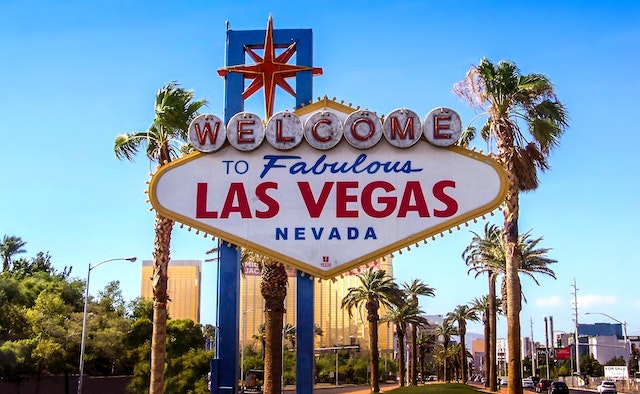
Why is Las Vegas in the desert? Because it is a good location for a stop on the new southern Californian railway line.
Las Vegas wasn’t the first settlement to spring up in the desert of Utah. The area used to be lush marshland, but that all dried up and formed the Mojave Desert, except for an oasis where Las Vegas is. The first people to live there were Paleo-Indians, about 10,000 years ago. Early Native American tribes followed them about 2,000 years ago. They lived there until encroaching Americans and the Native American laws moved them off the land.
A Mexican explorer called Antonio Armijo arrived in the area with a group of traders in 1829. They settled 160 km northeast of where Las Vegas is, and the explorer rode off to find water for the group. He found the oasis and named it Las Vegas, which means “the meadows”. Mexican settlers began to move into the area.
Over the next few years, Mormon settlers also moved in. Mormons were generally persecuted across America, and they moved to Utah and Nevada to escape the persecution. The Mormons used a trail from Salt Lake City to Los Angeles, and the oasis of Las Vegas was a good halfway point. They built a fort and a small settlement. By 1858, they had abandoned the area and it was mostly uninhabited.
Throughout the 19th century in America, railroads were slowly being built to connect the major population centers. The Union Pacific Railroad had reached the far side of Utah in 1879 and there was already a railway line to Los Angeles. Two US senators and mining barons, one of them the senator for Utah, decided they wanted to continue the railroad from Los Angeles, up through Nevada, and into Utah to finish at Salt Lake City. Construction started in 1899. It took a while and a fight with the Union Pacific Railroad company, but they had managed to build the railroad from Los Angeles to Salt Lake City by 1905.
Before 1905, Las Vegas was still an almost uninhabited settlement. Steam trains making the trip from Salt Lake City to Los Angeles couldn’t go the whole way without filling up with water at some point. Las Vegas was a perfect place to stop because it was halfway along the route, and it had a water supply from the oasis. Trains stopped there to fill up with water and the passengers usually disembarked because the refill took about an hour. These passengers wanted something to do, and it didn’t take long before saloons, stores, and even hotels started to appear. A second railway line was built going off from Las Vegas to the town of Bullfrog and the number of customers skyrocketed. Las Vegas was incorporated as a city in 1911.
Gambling was illegal in Nevada at the time, but gambling became common in Las Vegas as most of the people there were through trade, railroad workers, and ranchers. However, things were looking rocky at the end of the 1920s. The railway line went bankrupt, and it had to be sold to the Union Pacific. There were also many national strikes. This, coupled with the ban on gambling, started to hurt Las Vegas financially.
The Great Depression in the early ‘30s could have destroyed Las Vegas, but fortune smiled at the city. Nevada legalized gambling in 1931, and Las Vegas became bigger, but its future was still not assured. President Franklin D. Roosevelt started building the Hoover Dam in 1931 and at its peak over 5,000 laborers worked on it. These people lived in a camp near to the dam, and a lot of them were single men who were being paid and they needed somewhere to let their hair down. Las Vegas was only about 60 km away. Every weekend, scores of these workers would come into the town to gamble. Not all of the men were single and many more brought their families with them. Las Vegas was a good place for the families to settle down while the men worked on the dam. The Hoover Dam saved Las Vegas.
After World War 2, when the country was looking for a way to forget the war, the hotels and the casinos in Las Vegas started to get bigger and fancier. The mafia started to take over, became more powerful, and opened up more hotels. Surprisingly, the Mormon Church also invested heavily in Las Vegas. The mob ruled until the 1980s when big businesses and hotel chains moved in and started to create the mega hotels that we can see in Las Vegas today. And this is what I learned today.
Photo by Pixabay: https://www.pexels.com/photo/attraction-building-city-hotel-415999/
Sources
https://en.wikipedia.org/wiki/Los_Angeles_and_Salt_Lake_Railroad
https://en.wikipedia.org/wiki/Las_Vegas
https://en.wikipedia.org/wiki/History_of_Las_Vegas
https://www.american-rails.com/history.html
https://www.ktnv.com/positivelylv/northern-nevada-railway-how-railroads-helped-build-nevada
